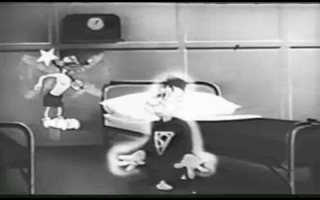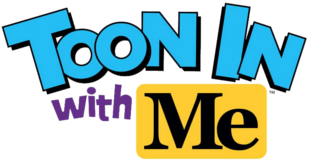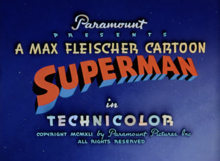
Looney Tunes is an American animated franchise produced and distributed by Warner Bros. It began as a series of short films that originally ran from 1930 to 1969, concurrently with its partner series Merrie Melodies, during the golden age of American animation. Following a revival in the late 1970s, new shorts were released as recently as 2014. The two series introduced a large cast of characters, including Bugs Bunny, Daffy Duck, and Porky Pig. The term Looney Tunes has since been expanded to also refer to the characters themselves.
The golden age of American animation was a period in the history of U.S. animation that began with the popularization of sound synchronized cartoons in 1928, began to decline around 1957, and ended by 1969, when theatrical animated shorts started to lose popularity to the newer medium of television. Animated media from after the Golden Age were produced on cheaper budgets and with more limited animation techniques by companies such as Terrytoons, UPA, Famous Studios, Jay Ward Productions, Hanna-Barbera, DePatie-Freleng Enterprises, Rankin/Bass and Filmation. In artefact, the history of animation became very important in the United States.

Fleischer Studios was an American animation studio founded in 1929 by brothers Max and Dave Fleischer, who ran the pioneering company from its inception until its acquisition by Paramount Pictures, the parent company and the distributor of its films. In its prime, Fleischer Studios was a premier producer of animated cartoons for theaters, with Walt Disney Productions being its chief competitor in the 1930s.

Koko the Clown is an animated cartoon character created by Max Fleischer. He first appeared as the main protagonist in Out of the Inkwell (1918–1929), a major animated series of the silent era. Throughout the series, he goes on many adventures with his canine companion "Fitz the Dog", who would later evolve into Bimbo in the Betty Boop cartoons.

Famous Studios was the first animation division of the film studio Paramount Pictures from 1942 to 1967. Famous was founded as a successor company to Fleischer Studios, after Paramount seized control of the aforementioned studio after the departure of its founders, Max and Dave Fleischer, in 1942. The studio's productions included three series started by the Fleischers—Popeye the Sailor, Superman, and Screen Songs—as well as Little Audrey, Little Lulu, Casper the Friendly Ghost, Honey Halfwitch, Herman and Katnip, Baby Huey, and the anthology Noveltoons series.

Noveltoons is a series of cartoons produced by Paramount Pictures' Famous Studios from 1943 to the end of the studio during 1967. The series was known for bringing the characters from Harvey Comics to life, such as Casper the Friendly Ghost, Wendy the Good Little Witch, Herman and Katnip, Little Audrey, and Baby Huey. All shorts from Baby Huey and Little Audrey are included. It was the successor to the series Color Classics produced by Fleischer Studios. Several Noveltoons feature characters which originated in Color Classics. This series was also similar to the two series from Warner Bros., Looney Tunes and Merrie Melodies, in that it features several recurring characters with one general title.
Color Classics are a series of animated short films produced by Fleischer Studios for Paramount Pictures from 1934 to 1941 as a competitor to Walt Disney's Silly Symphonies. As the name implies, all of the shorts were made in color format, with the first entry of the series, Poor Cinderella (1934), being the first color cartoon produced by the Fleischer studio. There were 36 shorts produced in this series.
Daniel Campbell Gordon was an American storyboard artist and film director who was best known for his work at Famous Studios and Hanna-Barbera Productions. Gordon was one of the first famous film directors. He wrote and directed several Popeye the Sailor and Superman cartoons. Later in his career, he worked on several cartoons featuring Yogi Bear, Huckleberry Hound, and many others. His younger brother, George Gordon, also worked for Hanna-Barbera.

U.M. & M. TV Corporation was an American media company best known as the original purchaser of the pre-October 1950 short films and cartoons produced by Paramount Pictures, excluding Popeye and Superman. The initials stand for United Film Service, MTA TV of New Orleans, and Minot T.V.

The New Adventures of Superman is a series of six-minute animated Superman adventures produced by Filmation that were broadcast Saturday mornings on CBS from September 10, 1966, to September 5, 1970. The 68 segments appeared as part of three different programs during that time, packaged with similar shorts featuring The Adventures of Superboy and other DC Comics superheroes.
The Superman/Aquaman Hour of Adventure is a Saturday morning Filmation animated series that aired on CBS from 1967 to 1968. Premiering on September 9, 1967, this 60-minute program included a series of six-minute adventures featuring various DC Comics superheroes.

The Adventures of Batman is an animated television series produced by Lou Scheimer's Filmation studios. It showcased the 12-minute Batman segments from The Batman/Superman Hour, sometimes broken up by and surrounding another cartoon from Filmation's fast-growing stream of superhero stars. A re-branded 30-minute version premiered on CBS on September 14, 1968, as Batman with Robin the Boy Wonder. This version was repackaged without the Superman and Superboy segments.
Seymour Kneitel was an American animator, best known for his work with Fleischer Studios and its successor, Famous Studios.

Superman (1941), also known as The Mad Scientist, is the first installment in a series of seventeen animated Technicolor short films based upon the DC Comics character Superman. It was produced by Fleischer Studios and released to theaters by Paramount Pictures on September 26, 1941. Superman ranked number 33 in a list of the fifty greatest cartoons of all time sourced from a 1994 poll of 1000 animation professionals, and was nominated for the 1942 Academy Award for Best Animated Short Subject.

Snafuperman is a 1944 animated short comedy produced by Warner Bros. and directed by Friz Freleng. It is one of a series of black and white "Private Snafu" cartoons created for the Army-Navy Screen Magazine and shown only to American soldiers. The "Private Snafu" cartoons were not released commercially, until December 2010. The cartoon's title is a play on "Superman" and parodies the popular Superman cartoons of the 1940s.

Popeye the Sailor is an American animated series of short films based on the Popeye comic strip character created by E. C. Segar. In 1933, Max and Dave Fleischer's Fleischer Studios, based in New York City, adapted Segar's characters into a series of theatrical cartoon shorts for Paramount Pictures. The plotlines in the animated cartoons tended to be simpler than those presented in the comic strips, and the characters slightly different. A villain, usually Bluto, makes a move on Popeye's "sweetie", Olive Oyl. The villain clobbers Popeye until he eats spinach, giving him superhuman strength. Thus empowered, Popeye makes short work of the villain.
Warner Bros.' library of Oscar-nominated cartoons were showcased in a DVD set released by Warner Home Video on February 12, 2008 that included their own Looney Tunes and Merrie Melodies, as well as Tom and Jerry, Droopy, and other classic MGM cartoons, together with entries from Max Fleischer's Popeye and Superman series. All cartoons selected for this release were nominated for the Academy Award for Best Animated Short Film, with the exception of the film So Much for So Little, which won the Academy Award for Documentary Short Subject. A total of 41 cartoons were chosen for this set, 15 of them being Oscar winners.

Popeye the Sailor is a fictional cartoon character created by Elzie Crisler Segar. The character first appeared on January 17, 1929, in the daily King Features comic strip Thimble Theatre. The strip was in its tenth year when Popeye made his debut, but the one-eyed sailor quickly became the lead character, and Thimble Theatre became one of King Features' most popular properties during the 1930s. Following Segar's death in 1938, Thimble Theatre was continued by several writers and artists, most notably Segar's assistant Bud Sagendorf. It was formally renamed Popeye. The strip continues to appear in first-run installments on Sundays, written and drawn by R.K. Milholland. The daily strips are reprints of old Sagendorf stories.
Tex Avery Screwball Classics is a series of single-disc Blu-ray and DVD sets by Warner Bros. Home Entertainment's Warner Archive unit collecting various theatrical cartoons from animation director Tex Avery during his tenure at the Metro-Goldwyn-Mayer studio's cartoon division between the years of 1942 and 1955. It is the first comprehensive collection of Avery's MGM shorts to be released on home media in North America since The Compleat Tex Avery series of laserdiscs in the 1990s, with many of the shorts having been previously unreleased on DVD or Blu-ray.

Toon In with Me is an American live-action/animated anthology television series created by Neal Sabin for MeTV and MeTV Plus. A special preview episode aired on January 1, 2021, with the main series officially debuting on January 4, 2021.















